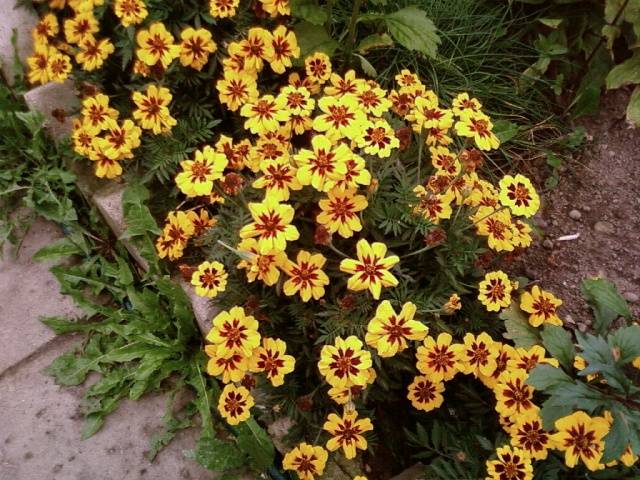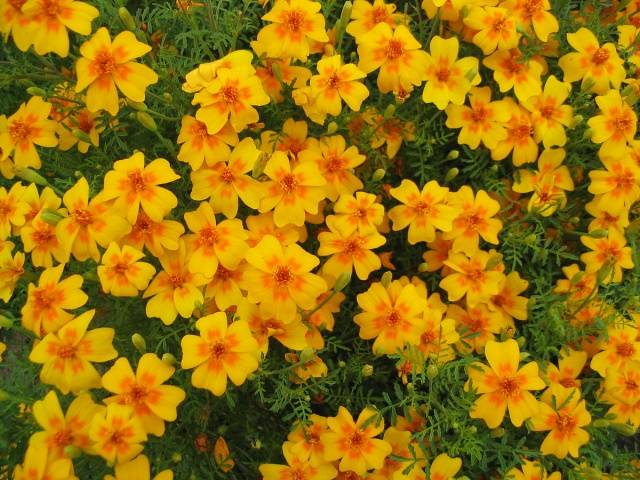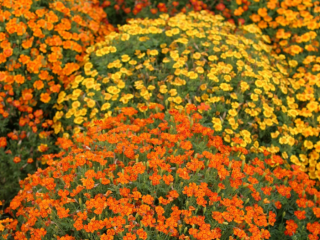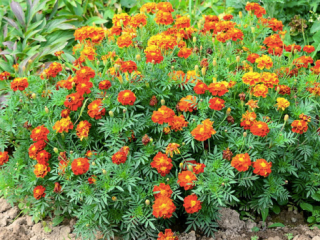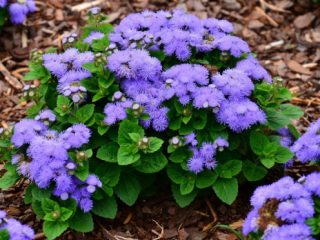Content
Marigolds came to Europe back in the seventeenth century, but later these flowers were somehow forgotten and they began to be used less and less. Today, variegated inflorescences are again at the peak of popularity; to date, more than fifty species of these plants have been bred, each of which has hundreds of varieties. There are both annual and perennial marigolds, among them there are inflorescences of white, yellow, orange and coral shades, there are tall and compact bushes - any gardener will be able to choose a variety to suit his taste. The main advantage of marigolds is their unpretentiousness; growing these flowers is very simple.
The most popular varieties of marigolds with photos and names will be given in this article. Here we will talk about the main characteristics of amazing flowers, and provide a description of annual and perennial species.
Brief description of the species
The scientific name of these flowers is Tagetes. They belong to the Asteraceae family.Marigolds are known in every European country, but everywhere they are known under different names: in the UK - “Mary’s Gold”, the Germans call them “student flowers”, in Ukraine they say “Chernobrivtsy”. Even the Chinese know and revere this flower, calling it “a plant of a thousand years.”
The description of marigolds (Tagetis) is as follows:
- the stems of the plant are straight, their height varies from 20 to 200 cm (depending on the type);
- the root system is well developed, fibrous type;
- Tagetis leaves can be colored in all shades of green;
- the leaf shape is dissected, sometimes there are types of marigolds with whole leaves with denticles at the edges;
- the arrangement of leaves on the stem is opposite or alternate;
- the inflorescence consists of tubular and reed flowers, the shape and size of the flower greatly depend on the variety and species;
- Tagetis can be painted in white, red, yellow, lemon, brown, orange shades and in a motley combination of these colors;
- marigolds exude a strong tart aroma, somewhat similar to the smell of asters;
- the flowering period lasts from June until the onset of frost;
- Tagethys fruit is a strongly flattened capsule with black or dark brown seeds;
- The Tagetis plant is very unpretentious, rarely gets sick, is practically not affected by pests, and does not require complex care.
Depending on the type of inflorescence, marigolds are divided into the following groups:
- Simple inflorescences (or non-double), which consist of no more than three rows of petals.
- Semi-double - those whose flower no more than half consists of simple reed petals.
- Terry tagetis should consist of more than 50% tubular or reed petals.
Based on the shape of the flowers, terry tagetis are usually divided into several subgroups:
- anemone-shaped - the border of the inflorescence consists of reed petals, and the central part is made of tubular ones;
- clove-shaped ones are made entirely of reed-type petals;
- chrysanthemum-shaped ones, on the contrary, contain only tubular petals.
Such a variety of species allows you to create complex compositions from marigolds alone or skillfully combine them with many other plants and flowers.
Division into types and varieties
Today, official science knows about 53 species of marigolds, among which there are both perennial and annual varieties. In Russia, not all varieties are widespread; most often, the country's flower growers grow only three types of marigolds: thin-leaved, deviated and erect.
Erect Tagethys
Photos of marigolds of this particular type are best known to Europeans, although the second name for the group is “African”. This species is usually classified as the tallest, annual flowers with a strong fibrous root system.
The shape of the bush is usually reverse pyramidal; the bush itself can be either compact or spreading (depending on the height and variety of plants). The height of erect Tagetis can vary from 40 to 120 cm, and therefore the entire African group of plants is usually divided into: low, medium, tall and giant.
The stems of erect varieties are smooth, the central shoot is well defined, and the side shoots are directed upward. The color of the leaves can vary from light to dark shades of green, the shape of the leaf is pinnately dissected.
The baskets are large, up to 13 cm in diameter.They can be semi-double, double or single. African tagetis begin to bloom at the end of June or early July, and end with the first frosts.
Antigua
This variety of marigolds is interesting because of the compactness of the bush, which grows only 20 cm. At the same time, the inflorescences are very large - about 10 cm in diameter, and there are really a lot of them on the bushes. Antigua variety Tagetis are colored in a lemon or rich yellow shade.
Hawaii
Giant bushes of these marigolds can grow up to 105 cm. The flowers are also very large - about 12 cm in diameter. The baskets are painted in a beautiful orange shade. The Hawaii variety blooms later - the buds bloom only in mid-August.
Gold Dollar
Despite their gigantic size (more than 110 cm), the bushes of these Tagetis are very compact and take up little space in the flowerbed. The stems are powerful and thick, the leaves on Tagetis are large and light green. The flowers themselves are colored red or red-orange, massive, semi-double.
Kilimanjaro
The bushes are large, about 70-80 cm high. The inflorescences are spherical, very large, and densely double. Kilimanjaro marigolds are painted white. The variety is intended for growing Tagetis for cutting.
Glitters
The bushes of this variety are very tall - more than a meter, but the inflorescences themselves are small. The diameter of the flowers reaches a maximum of 6 cm, and they are painted in a beautiful yellow shade.
Goldlicht
The bushes are compact and neat, their height reaches only 65 cm. The stems are very strong, smooth, the leaves are massive and green.The baskets are hemispherical, belong to the carnation type, very thick and terry, painted in an orange tint. Tagetis begins to bloom early (at the end of June).
Freels
Compact, non-spreading bushes up to only 80 cm in height. The inflorescences are densely double, large (about 10 cm in diameter), painted in a beautiful golden-orange color. The variety begins to bloom at the end of July or in the first half of August, which makes it possible to classify Tagetis as a late variety.
Rejected type
It is easy to recognize the Tagethys of this group from photos of flowers - the inflorescences of all varieties of rejected marigolds are small. Flowers from this group are often called French marigolds or small-flowered ones.
All marigolds of this species are perennials, they have many erect, highly branched stems, the height of which can vary from 15 to 60 cm. The lateral stems deviate strongly to the sides.
The leaves are dark green, lanceolate, small in size, and have a serrated edge. The inflorescences are small, maximum 4-6 cm in diameter. The shape of the flower can be simple, double or semi-double.
The group contains both single-color varieties and many species with two-color inflorescences. Rejected tagetis begin to bloom early - in early June. The peak of flowering occurs in mid-summer and ends with the first frost.
Bolero
The variety is new, but very popular. The height of the bushes reaches only 30 cm. The size of the baskets is medium, the structure is terry. Of particular interest is the color of marigolds - red-brown with small splashes of gold. Tagetis are considered fast-growing; they will bloom throughout the warm season.
Naughty Marietta
A very popular marigold variety in Russia with compact bushes, highly branched shoots and small flat-shaped inflorescences. The flowers are painted in two shades: the edges of the petals are golden and the center is red. Tagetis is unpretentious; from the beginning of July until September it will delight the summer resident with abundant flowering.
Bonanza
This group includes several varieties with a similar name; they differ in the color of the inflorescences. Marigolds are perennial, compact, about 30 cm high. Tagetis are large - about 6 cm, terry type, painted in red-orange, yellow, red or brown shades.
Gold Ball
The height of the bushes is up to 60 cm, they are spreading, with powerful, even shoots. A distinctive feature of Tagetis is a brown coating on green stems. The baskets are medium in size - up to 5 cm, their shape is semi-double. Gold Ball is considered an early variety of marigold; they begin to bloom in early June.
Jolly Jester
With a small bush height (only 30 cm), these plants are distinguished by strong branching of shoots. The flowers are single, simple in shape, but of an interesting mixed color - one half of the petal is yellow, the second is painted in a rich red tint.
Red Gem
The shape of the bush of these plants is spherical, the height is small - about 40 cm. An amazing feature is the huge number of inflorescences that are simply impossible to count. The flowers are flat, simple in shape, painted in a beautiful red hue, the petals have a yellow border.
Thin-leaved tagetis
This group includes annual varieties of Tagetis with compact, highly branched bushes, the height of which ranges from 20 to 50 cm. The shoots are bare, smooth and straight, painted in a light green shade. The leaves are small, pinnately dissected, and arranged alternately.
The inflorescences are collected from simple baskets with five petals, the type of flowers is corymbose, the diameter is 15-30 mm. The inflorescences can be painted in one or two colors. Due to the strong branching of the shoots, the bushes resemble a ball and look very impressive.
Narrow-leaved tagetis begin to bloom in early June, and fade only with the onset of stable cold weather, when the temperature drops to 1-2 degrees.
Lemon Jam
The height of the bushes is only 30-35 cm, the inflorescences are painted in a juicy lemon shade. Flowering is very abundant and long lasting.
Mimimix
Ball-shaped dense bushes, only 25 cm high. The whole plant is densely strewn with small flowers of simple shape. The heads of the plants are colored red-orange.
Golden Ring
The shoots of this tagetis are tall (up to 50 cm), but very fragile and thin. The flowers on the bushes are small, up to three centimeters in diameter, and painted golden. The plant blooms in June and delights the gardener with its variegated colors until late autumn.
Dwarf
Globular small bushes, only about 25 cm high. The peculiarity of the variety is a large number of leaves, which makes the bush densely packed and lush. The small inflorescences have a complex shape and consist of five yellow reed petals and several orange tubular petals. The Gnome variety blooms early.
Conclusion
There are many varieties of marigolds, which once again proves the popularity of these flowers. Plants are divided not only by the height of the bush, but by the shape and structure of the inflorescence; Tagetis are distinguished by the length and branching of the stem, by the growing season and flowering period. This article presents only the best varieties of plants that are perfect for growing in Russia.















